| dc.contributor.author | Nascimento, Daniel L. | |
| dc.contributor.author | Foscato, Marco | |
| dc.contributor.author | Occhipinti, Giovanni | |
| dc.contributor.author | Jensen, Vidar Remi | |
| dc.contributor.author | Fogg, Deryn Elizabeth | |
| dc.date.accessioned | 2021-09-29T10:27:53Z | |
| dc.date.available | 2021-09-29T10:27:53Z | |
| dc.date.created | 2021-09-28T10:26:50Z | |
| dc.date.issued | 2021 | |
| dc.identifier.issn | 0002-7863 | |
| dc.identifier.uri | https://hdl.handle.net/11250/2785971 | |
| dc.description.abstract | Bimolecular catalyst decomposition is a fundamental, long-standing challenge in olefin metathesis. Emerging ruthenium–cyclic(alkyl)(amino)carbene (CAAC) catalysts, which enable breakthrough advances in productivity and general robustness, are now known to be extraordinarily susceptible to this pathway. The details of the process, however, have hitherto been obscure. The present study provides the first detailed mechanistic insights into the steric and electronic factors that govern bimolecular decomposition. Described is a combined experimental and theoretical study that probes decomposition of the key active species, RuCl2(L)(py)(═CH2) 1 (in which L is the N-heterocyclic carbene (NHC) H2IMes, or a CAAC ligand: the latter vary in the NAr group (NMes, N-2,6-Et2C6H3, or N-2-Me,6-iPrC6H3) and the substituents on the quaternary site flanking the carbene carbon (i.e., CMe2 or CMePh)). The transiently stabilized pyridine adducts 1 were isolated by cryogenic synthesis of the metallacyclobutanes, addition of pyridine, and precipitation. All are shown to decompose via second-order kinetics at −10 °C. The most vulnerable CAAC species, however, decompose more than 1000-fold faster than the H2IMes analogue. Computational studies reveal that the key factor underlying accelerated decomposition of the CAAC derivatives is their stronger trans influence, which weakens the Ru−py bond and increases the transient concentration of the 14-electron methylidene species, RuCl2(L)(═CH2) 2. Fast catalyst initiation, a major design goal in olefin metathesis, thus has the negative consequence of accelerating decomposition. Inhibiting bimolecular decomposition offers major opportunities to transform catalyst productivity and utility, and to realize the outstanding promise of olefin metathesis. | en_US |
| dc.language.iso | eng | en_US |
| dc.publisher | American Chemical Society | en_US |
| dc.rights | Navngivelse 4.0 Internasjonal | * |
| dc.rights.uri | http://creativecommons.org/licenses/by/4.0/deed.no | * |
| dc.title | Bimolecular Coupling in Olefin Metathesis: Correlating Structure and Decomposition for Leading and Emerging Ruthenium−Carbene Catalysts | en_US |
| dc.type | Journal article | en_US |
| dc.type | Peer reviewed | en_US |
| dc.description.version | publishedVersion | en_US |
| dc.rights.holder | Copyright 2021 the authors | en_US |
| cristin.ispublished | true | |
| cristin.fulltext | postprint | |
| cristin.qualitycode | 2 | |
| dc.identifier.doi | 10.1021/jacs.1c04424 | |
| dc.identifier.cristin | 1939566 | |
| dc.source.journal | Journal of the American Chemical Society | en_US |
| dc.source.pagenumber | 11072–11079 | en_US |
| dc.relation.project | Norges forskningsråd: 262370 | en_US |
| dc.relation.project | Norges forskningsråd: 226244 | en_US |
| dc.relation.project | Norges forskningsråd: 288135 | en_US |
| dc.relation.project | Notur/NorStore: NS2506K | en_US |
| dc.relation.project | Notur/NorStore: NN2506K | en_US |
| dc.identifier.citation | Journal of the American Chemical Society. 2021, 143, 29, 11072–11079. | en_US |
| dc.source.volume | 143 | en_US |
| dc.source.issue | 29 | en_US |

